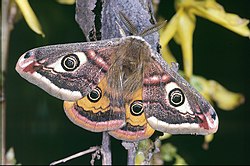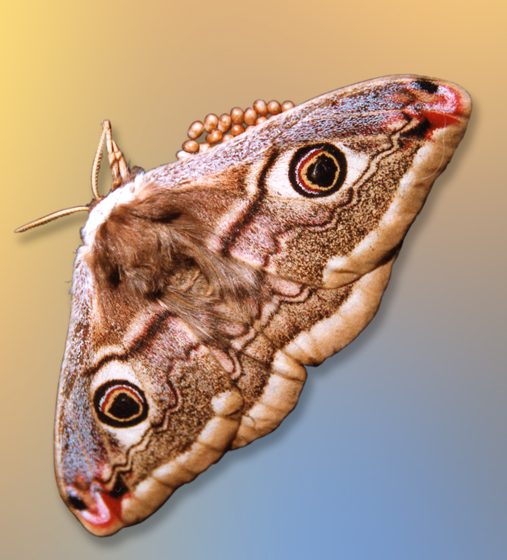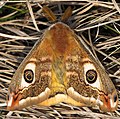Saturnia (Eudia) pavoniella – Scopoli, 1763
Descrizione
La Saturnia pavoniella è vicariante della Saturnia pavonia in Italia e in alcune regioni dell’Europa centro-meridionale.
È una specie con evidente dimorfismo sessuale, le femmine, infatti, sono più grandi (con un’apertura alare che può essere compresa tra 5,0 e 9,5 cm circa) e hanno livrea grigiastra; i maschi sono più piccoli (apertura alare è di circa 4,5-7,0 cm) e hanno livrea brunastra e ocra.
La pavonia minore è caratterizzata dalla presenza di macchie ocellari ben visibili, cerchiate più volte.
Nel sito www.leps.it leggiamo che la Saturnia pavoniella è stata separata dalla Saturnia pavonia da Huemer & Nässig (2003) per vari motivi; in particolare:
- a causa dell’infertilità dell’ibrido (sia in esemplari femminili, sia nella maggior parte dei maschi)
- per differenze consistenti nelle marcature dell’ala
- per differenze nella morfologia genitale
Le larve si nutono di varie specie di piante: Rubus, Prunus spinosa, Crataegus, Quercus, Carpinus, Betula, Salix, Erica, Vaccinium, Spiraea, Filipendula, Lythrum, Potentilla, Rosa, Calluna, Hippophae.
Ha una sola generazione annuale con sfarfallamento primaverile.
I bruchi vivono su piante basse e su cespugli vari.
Gli adulti si involano da febbraio a giugno.
La pavonia è tra le farfalle che producono bozzoli sericei più grandi.
Gli adulti non si nutrono, in quanto sono dotati di apparato boccale totalmente non funzionale.
Per tale motivo la vita da farfalla di questo lepidottero è davvero assai breve.
Specie simili
Saturnia (Eudia) pavonia – Linnaeus, 1758
Farfalla notturna della famiglia dei Saturnidi, è specie vicariante della Saturnia pavoniella nell’Europa settentrionale e centrale.
È caratterizzata dalla presenza di macchie ocellari ben evidenti e cerchiate più volte.
Gli adulti di pavonia minore non possono nutrirsi in quanto dotati di un apparato boccale non funzionale: per questo la loro vita da falena è assai breve.
Le larve si nutrono di diverse piante: Alchemilla, Alnus, Arbutus, Betula, Calluna, Cornus, Crataegus, Erica, Fagus, Filipendula, Fragaria, Fraxinus, Hippophae, Humulus, Juglans, Lythrum, Malus, Myrica gale, Pistacia, Populus, Potentilla, Prunus, Pyrus, Quercus, Rhamnus, Rosa, Rubus, Rumex, Salix, Sambucus, Schinus, Sorbus, Spiraea, Ulmus, Vaccinium.
Galleria
La fotografia riportata nella galleria fotografica è stata scattata da Giampaolo Filippucci e Tiziana Ravagli lungo l’itinerario n. 1 proposto nel volume Trevi quattro passi tra storia e natura, tra Torre Matigge e Trevi
Saturnia pavoniella
 Link da Moths and Butterflies of Europe and North Africa [www.leps.it]: Saturnia (Eudia) pavoniella – Scopoli, 1763
Link da Moths and Butterflies of Europe and North Africa [www.leps.it]: Saturnia (Eudia) pavoniella – Scopoli, 1763
Contents
Saturnia pavoniella
| Saturnia pavoniella | |
|---|---|

| |
| Male from Friuli-Venezia Giulia, Italy | |
| Scientific classification | |
| Domain: | Eukaryota |
| Kingdom: | Animalia |
| Phylum: | Arthropoda |
| Class: | Insecta |
| Order: | Lepidoptera |
| Family: | Saturniidae |
| Genus: | Saturnia |
| Species: | S. pavoniella
|
| Binomial name | |
| Saturnia pavoniella (Scopoli, 1763)
| |
| Synonyms | |
| |
Saturnia pavoniella is a moth of the family Saturniidae. It is found in the alpine regions of Austria, Italy (including Sicily) and the Czech Republic across south-eastern Europe to northern Turkey and the Caucasus. It is possibly also present in south-eastern France.

The wingspan is 45–70 mm (1.8–2.8 in) for males and 50–95 mm (2.0–3.7 in) for females. Adults are on wing from February to June. In northern Greece they are mainly found in May.
The larvae feed on a wide variety of plants. Recorded foodplants include Betula, Calluna, Carpinus, Crataegus, Erica, Filipendula, Hippophae, Lythrum, Malus, Potentilla, Prunus spinosa, Pyrus, Quercus Rosa, Rubus, Salix, Spiraea and Vaccinium. In northern Greece the preferred hosts are Rubus ulmifolius and Pyrus amygdaliformis.
Gallery
External links
Saturnia pavonia
 Link da Moths and Butterflies of Europe and North Africa [www.leps.it]: Saturnia (Eudia) pavonia – Linnaeus, 1758
Link da Moths and Butterflies of Europe and North Africa [www.leps.it]: Saturnia (Eudia) pavonia – Linnaeus, 1758
Contents
Saturnia pavonia
| Small emperor moth | |
|---|---|

| |
| Male | |
| Scientific classification | |
| Domain: | Eukaryota |
| Kingdom: | Animalia |
| Phylum: | Arthropoda |
| Class: | Insecta |
| Order: | Lepidoptera |
| Family: | Saturniidae |
| Genus: | Saturnia |
| Species: | S. pavonia
|
| Binomial name | |
| Saturnia pavonia | |
| Synonyms | |
| |

Saturnia pavonia, the small emperor moth, is a moth of the family Saturniidae. It was first described by Carl Linnaeus in his 1758 10th edition of Systema Naturae. Sometimes, the incorrect genus name Pavonia is still used for this species. This moth occurs throughout the Palearctic region and is the only member of its family to be found in the British Isles, where it is usually called simply the emperor moth.
Description
The male has a wingspan of about 60 mm (2.4 in) with brown and white forewings marked with red and orange fascia and a bold black and orange eyespot. The hindwings are orange with a similar eyespot. The female is larger with a wingspan of about 80 mm (3.1 in), but less brightly coloured than the male, being generally grey and white but has all wings marked with eyespots similar to the male.
The male flies rapidly during the day from mid-April to late June looking for the rather sluggish females, which usually only fly at night. The species inhabits a range of habitats but is most often associated with heathland and moorland.
The caterpillar is black and orange at first, later becoming green with black rings and yellow and red spots. The commonest food plant is heather but the species has also been recorded feeding on a huge range of other plants (see list below). The species overwinters as a pupa within a fibrous cocoon.
Subspecies
- Saturnia pavonia pavonia (southern Spain and possibly Morocco)
- Saturnia pavonia josephinae (Schawerda, [1924]) (southern Spain and possibly Morocco)
-
Caterpillars and eggs
-
Younger caterpillar
-
Caterpillar (top view)
-
Older caterpillar and the start of pupation
-
Both sides of male specimen
-
Both sides of female specimen
-
Crawling caterpillar (video)
Recorded food plants
S. pavonia larvae have been recorded feeding on Alchemilla, Alnus, Arbutus, Betula, Calluna, Cornus, Crataegus, Erica, Fagus, Filipendula, Fragaria, Fraxinus, Hippophae, Humulus, Juglans, Lythrum, Malus, Myrica gale, Pistacia, Populus, Potentilla, Prunus, Pyrus, Quercus, Rhamnus, Rosa, Rubus, Rumex, Salix, Sambucus, Schinus,[citation needed] Sorbus, Spiraea, Ulmus, Vaccinium.
References
- Chinery, Michael. Collins Guide to the Insects of Britain and Western Europe, 1986 (Reprinted 1991).
- Skinner, Bernard. Colour Identification Guide to Moths of the British Isles, 1984.
- Waring, Paul, Martin Townsend and Richard Lewington. Field Guide to the Moths of Great Britain and Ireland, 2003.
External links
- Emperor moth. UKmoths
- Savela, Markku. "Saturnia pavonia (Linnaeus, 1758)". Lepidoptera and Some Other Life Forms. Retrieved November 15, 2018.
- Lepiforum e.V.



![Bruco adulto di Saturnia pavonia [photo credit: michel-candel www.flickr.com/photos/ 84942480@N03/27518968774 saturnia pavonia chenille - Perpignan de la grave via photopin creativecommons.org/licenses/by-nc-sa/2.0/]](https://www.treviambiente.it/ambienteebiodiversita/wp-content/uploads/sites/9/2016/10/27518968774_0fb58a7156_b-saturnia-pavonia-bruco-560x560.jpg)
![Saturnia pavonia, bruco giovane [photo credit: Darius Baužyswww.flickr.com/photos/45976201@N06/6802313333The Small Emperor Moth (Saturnia pavonia) via photopincreativecommons.org/licenses/by-sa/2.0/]](https://www.treviambiente.it/ambienteebiodiversita/wp-content/uploads/sites/9/2016/10/6802313333_87e550cf1c_b-saturnia-pavonia-bruco-giovane-560x560.jpg)














